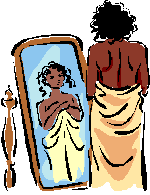
Body Dysmorphic
Disorder, (BDD) is listed in the DSM-IV under somatization disorders, but
clinically, it seems to have similarities to Obsessive-Compulsive Disorder
(OCD).
BDD is a
preoccupation with an imagined physical defect in appearance or a vastly
exaggerated concern about a minimal defect. The preoccupation must cause
significant impairment in the individual’s life. The individual thinks about
his or her defect for at least an hour per day.
The individual’s
obsessive concern most often is concerned with facial features, hair or odor.
The disorder often begins in adolescence, becomes chronic and leads to a great
deal of internal suffering.
The person may fear
ridicule in social situations, and may consult many dermatologists or plastic
surgeons and undergo painful or risky procedures to try to change the perceived
defect. The medical procedures rarely produce relief. Indeed they often lead to
a worsening of symptoms. BDD may limit friendships. Obsessive ruminations about
appearance may make it difficult to concentrate on schoolwork.
Other behaviors that
may be associated with BDD
-
Frequent
glancing in reflective surfaces
-
Skin
picking
-
Avoiding
mirrors
-
Repeatedly
measuring or palpating the defect
-
Repeated
requests for reassurance about the defect.
-
Elaborate
grooming rituals.
-
Camouflaging
some aspect of one’s appearance with one’s hand, a hat, or makeup.
-
Repeated
touching of the defect
-
Avoiding
social situations where the defect might be seen by others.
-
Anxiety
when with other people.
BDD tends to be
chronic and can lead to social isolation, school dropout major depression,
unnecessary surgery and even suicide.
It is often
associated with social phobia and OCD, and delusional disorder. Chronic BDD can
lead to major depressive disorder. If it is associated with delusions, it is
reclassified as Delusional disorder, somatic subtype. Bromosis (excessive
concerns about body odor) or Parasitosis (concern that one is infested by
parasites) can classically be associated with delusions.
Other conditions that
might be confused with BDD: Neglect caused by a parietal lobe brain lesion;
anorexia nervosa, gender identity disorder.
Milder body image
disturbances that do not meet criteria for BDD. :
-
Benign
dissatisfaction with one’s looks. This does not affect the person’s
quality of life. 30-40% of Americans may have these feelings.
-
Moderate
disturbance with one’s body image. The person’s concerns about
appearance cause some intermittent anxiety or depression.
Treatment: It is at
times difficult to get an individual with BDD into psychiatric treatment because
he or she may insist that the disorder has a physical origin. We prefer that the
referring physician call us in advance so that we can strategize on how best to
encourage the individual to accept help. Treatment often
involves the use of SSRI medications (such as sertraline or fluoxetine) and
cognitive-behavioral psychotherapy. In this type of psychotherapy the therapist
helps the affected individual resist the compulsions associated with the BDD
such as repeatedly looking in mirrors or excessive grooming (response
prevention) If the individual
avoids certain situations because of fear of ridicule, he or she should be
encouraged to gradually and progressively face feared situations. If the
individual plans to seek invasive medical/surgical treatment, the therapist
should attempt to dissuade the patient or ask permission to talk with the
surgeon. The therapist helps the individual to understand how some of his or her
thoughts and perceptions are distorted and helps the patient replace these
perceptions with more realistic ones. Family
behavioral treatment can be useful, especially if the affected individual is an
adolescent. Support groups if available, can help.
For more information,
read The Broken Mirror or Learning to Live with Body Dysmorphic
Disorder by Katharine Phillips, M.D.
Return to our Anxiety Home Page

